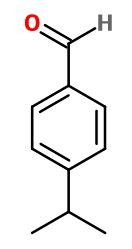Cuminaldehyde
Naturelle - Synthétique
Spicy > Warm Spices > Dry Woods > Anisic

Crédits photo: ScenTree SAS
Other names :
4-propan-2-ylbenzaldehyde ; Cuminaldehyde ; 4-isopropyl benzaldehyde ; Cumaldehyde ; Cuminal ; Cuminic aldehyde
Volatility :
Head
Uses in perfumery :
Cuminaldehyde is used in leather, spicy notes, in heavy and spicy flower accords (e. g. carnation), in oriental and woody accords and for sweaty notes. Used as a replacor for Cumin EO, in which it is found at about 30% of the composition.
Natural availability :
Cuminaldehyde can be extracted in its natural state from Cumin EO, as it represents 40% of its composition.
Year of discovery :
Data not available.
Other comments :
Data not available.
Price Range :
€€€
Stability :
Aldehydes may form diethylacetals in alcoholic perfumes, with no real impact on their smell
Most of the time, the occurrence of a benzenic cycle in a molecule causes a coloration of this molecule through time
Most of the time, the occurrence of a benzenic cycle in a molecule causes a coloration of this molecule through time

Crédits photo: ScenTree SAS
- Molecular formula :
- C10H12O
- Molecular Weight :
- 148,2 g/mol
- Density :
- 0,985
- Flash Point :
- 94°C
- Fusion Point :
- Donnée indisponible.
- Appearance :
- Colorless liquid
- Log P :
- 2,98
- Boiling Point :
- 235°C
- Detection Threshold :
- 34,1731 ng/l
Synthesis route :
Cuminaldehyde synthesis is made by reduction of 4-Isopropylbenzoyl chloride or by formylation of cumene.
Synthesis precursor :
Cuminaldehyde is the precursor to several raw materials. Its oxidation gives Cuminic Acid, the hydrogenation of the aldehyde function leads to Cuminic Alcohol and its total hydrogenation synthesizes Mayol with a smell of lily of the valley. It can also form a Schiff base with Methyl Anthranilate, with a fruity and more artificial smell, or a dimethyl acetal which also has an olfactory interest.
Isomerism :
The ortho and meta isomers isolated from Cuminaldehyde are not used in fine perfumery.
Cuminaldehyde is a constitutional isomer of Anethole, which has a very different smell reminiscent of Star Anise EO.
- EINECS number :
- 204-516-9
- FEMA number :
- 2341
- JECFA number :
- 868
- FLAVIS number :
- 05.022
- Allergens :
- This ingredient does not contain any allergen.
- IFRA :
- This ingredient is restricted by IFRA
- Restriction type :
- RESTRICTION
- Cause of restriction :
- DERMAL SENSITIZATION
- Amendment :
- 49
- Quantitative limit on the use :
-
Cat.1 Cat.2 Cat.3 Cat.4 Cat.5A Cat.5B Cat.5C Cat.5D Cat.6 0,085 % 0,025 % 0,51 % 0,47 % 0,12 % 0,12 % 0,12 % 0,12 % 0,28 % Cat.7A Cat.7B Cat.8 Cat.9 Cat.10A Cat.10B Cat.11A Cat.11B Cat.12 0,96 % 0,96 % 0,05 % 0,92 % 3,3 % 3,3 % 1,8 % 1,8 % No Restriction - Restriction type :
- RESTRICTION QRA
- Cause of restriction :
- SENSITIZATION
- Amendment :
- 47
- Quantitative usage limits :
-
Cat.1 Cat.2 Cat.3 Cat.4 Cat.5 Cat.6 Cat.7 Cat.8 Cat.9 Cat.10 Cat.11 0,03 % 0,04 % 0,17 % 0,5 % 0,26 % 0,8 % 0,08 % 1,11 % 5 % 2,5 % Not Restricted
To learn more about IFRA's standards : https://ifrafragrance.org/safe-use/library
ScenTree is solely responsible for the information provided here.
Do you sell any of the raw materials? Would you like to let our users know?
Send an email to fournisseurs@scentree.co to learn about our advertising opportunities.
